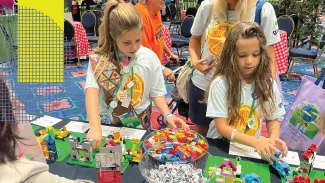
Planting a seed: The impact of Architecture Week
Here's how two AIA chapters are bringing Architecture Week to their communities.
This year, 20 AIA chapters from all over the country received Architecture Week grants from AIA National to create innovative outreach programming in their local communities. They’ve been gearing up for April 13-19, when they’ll get to see those plans come to fruition. The program's emphasis this year is on K-12 students, especially those from underrepresented backgrounds, with the goal of engaging 15,000 students via 60 AIA chapters.
“What I really love about these programs is that they start to explore the impact that architecture has and how many opportunities there are for different types of people,” says Katie Hitt Deaton, Assoc. AIA, of Acme Brick. Deaton is involved with organizing Architecture Week activities for her local chapter, AIA Fort Worth, which started its K-12 outreach program this year. “For year one, I’ve been pleased with how excited the community is.”
We chatted with Deaton and Denise Shaw, AIA, of AIA Chattanooga, about the challenges and rewards of inspiring the next generation of architects.
"There's a lot of momentum and enthusiasm in Fort Worth."
“We did a member poll, and there were several who were interested in starting a K-12 committee,” says Deaton of the committee’s origins. “We started last fall. We applied for the Architecture Week grant and received it. That really helped us to seed that committee. There’s a lot of enthusiasm and momentum in Fort Worth.”
“A lot of the members of the committee are architects who practice in the K-12 space,” she continues. “They have a lot of contacts, and a lot of passion for students. It’s been exciting to see it take off and move forward.”
Deaton explains that AIA Fort Worth is partnering with the Modern Art Museum of Fort Worth on a monthlong architecture-themed film series geared toward all ages. A free, interactive Box City program at the museum planned for Saturday, April 19, led by AIA Fort Worth members and local artist Claire Kennedy, invites children and families to explore the principles of architecture and urban design through creative play. A curated exhibition featuring studio work from high school students is on display all week.
“I always think of these efforts as trying to make architecture more accessible,” says Deaton. “Removing the cost, or some of those other barriers, it really goes a long way.”
In speaking about why she’s passionate about this work, Deaton, who previously worked on K-12 outreach work at AIA Dallas, says, “I found myself just very surprised and delighted by the creativity, the things the students come up with that I would have never thought of. Working with high school students, some of them are producing work that’s university level. It is crazy that they are coming out of high school with those skills and that creativity, and even the technical skill that so many of them have. I was just so impressed, at all levels—with the six-year-olds, with the questions that they would ask. It’s just been very rewarding, and I love it. I’m so glad that I get to continue to do a little bit of this in a volunteer capacity. It’s so fun.”
"They might just be solving problems in a different way."
For Denise Shaw, AIA, of Plumb Architecture, helping K-12 students learn about architecture feels personal.
“I was not a great student,” she says. “I was a very average student, and it took me going to college and studying architecture to finally be like, ‘Oh, I get it. This all makes sense to me.’”
Shaw says that when she was in school, project-based learning wasn’t the norm. “Book learning was not my methodology of being able to understand principles,” she says. “I want to [make sure] that kids feel confident and smart and trust that their brain is doing the right thing—they might just be solving problems in a different way.”
AIA Chattanooga, Shaw’s chapter, is partnering with the local library on two art installations and a showcase event, which took place this past Saturday. The art installations recruited two local artists to explore the interplay between art and architecture.
At Saturday’s event, Shaw observed teenagers building towers out of tubes and aluminum foil, rediscovering methods of trial and error that they may not have used since they were small children.
“[They were] using those observational skills to adjust their design or let it fall and then build something completely different, because you learned how not to do it from the first go-round. That failure is actually part of the learning process.”
Follow along with Architecture Week via AIA’s social media channels: Instagram, Facebook, and X.
Katherine Flynn is Director, Digital Content at AIA.
